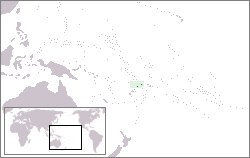 Wallis and Futuna, officially the Territory of the Wallis and Futuna Islands (French: Wallis et Futuna or Territoire des îles Wallis et Futuna, Fakauvea and Fakafutuna: Uvea mo Futuna), is a Polynesian French island territory (but not part of, or even contiguous with,French Polynesia. Wallis and Futuna is located at the very opposite western end of Polynesia) in the South Pacific between Tuvalu to the northwest, Rotuma of Fiji to the west, the main part of Fiji to the southwest, Tonga to the southeast, Samoa to the east, the New Zealand-associated state of Tokelau to the northeast and to a more distant north the Phoenix Islands (Kiribati).
Wallis and Futuna, officially the Territory of the Wallis and Futuna Islands (French: Wallis et Futuna or Territoire des îles Wallis et Futuna, Fakauvea and Fakafutuna: Uvea mo Futuna), is a Polynesian French island territory (but not part of, or even contiguous with,French Polynesia. Wallis and Futuna is located at the very opposite western end of Polynesia) in the South Pacific between Tuvalu to the northwest, Rotuma of Fiji to the west, the main part of Fiji to the southwest, Tonga to the southeast, Samoa to the east, the New Zealand-associated state of Tokelau to the northeast and to a more distant north the Phoenix Islands (Kiribati).
Its land area is 264 km2 with a population of about 15,000. Mata-Utu is the capital and biggest city. The territory is made up of three main volcanic tropical islands along with a number of tiny islets, and is split into two island groups that lie about 260 km apart, namely Wallis Islands (Uvea) in the northeast, and Hoorn Islands (Futuna Islands) in the southwest, including Futuna Island proper and the mostly uninhabited Alofi Island.
Since 2003 Wallis and Futuna has been a French overseas collectivity (collectivité d’outre-mer, or COM). Between 1961 and 2003, it had the status of a French overseas territory (territoire d’outre-mer, or TOM).
Although the Dutch and the British were the European discoverers of the islands in the 17th and 18th centuries, it was the French who were the first Europeans to settle in the territory, with the arrival of French missionaries in 1837, who converted the population to Roman Catholicism. Pierre Chanel, canonized as a saint in 1954, is a major patron of the island of Futuna and the region. Wallis is named after the British explorer, Samuel Wallis.
The culture of those islands is Polynesian, as is the music. Additionally, the Kailao, often thought of as a Tongan war dance, was imported to Tonga from ‘Uvea.

Notes from Wikipedia








